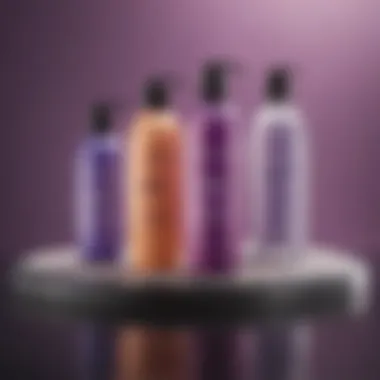Sulfate-Free Purple Shampoo and Conditioner Guide


Intro
Managing colored hair can be a complex endeavor. It requires a careful balance between preserving vibrancy and maintaining overall hair health. One popular solution among women seeking effective hair care is the use of sulfate-free purple shampoos and conditioners. They play a significant role in color maintenance, especially for blondes and those with gray hair. This article aims to provide a comprehensive overview of these products, their unique formulations, the benefits they offer, and tips for proper application and selection.
Understanding the relevance of sulfate-free formulations is essential in today’s beauty landscape. Sulfates can strip natural oils, leaving hair dry and damaged. Hence, many women are opting for sulfate-free alternatives that are gentler while still effective in achieving desired results. Purple shampoos and conditioners specifically target brassiness in blonde and gray hair, neutralizing unwanted yellow tones. This guide seeks to distill the valuable insights on how to choose and use these products for optimal hair care.
Fashion Trends
The world of hair care is closely intertwined with fashion trends. As styles evolve, so do the products we use to maintain them. Purple shampoo and conditioner have garnered attention not only for their functionality but also for their role in achieving sought-after looks.
Seasonal Styles
Each season brings its unique hairstyle preferences. In the spring and summer, lighter shades, such as platinum or soft blonde, become popular. Users of purple shampoo can find it beneficial to keep these shades looking fresh. As the cooler months approach, deeper hues gain traction, yet maintaining brightness in lighter colors remains a priority. In every season, a proper hair care routine utilizing sulfate-free products aids in ensuring that hair stays vibrant and healthy.
Influencer Inspirations
Social media influencers are pivotal in shaping hair trends. Many have shared their experiences with sulfate-free purple shampoos, showcasing transformations that resonate with audiences. From Instagram to TikTok, vivid before-and-after images highlight the effectiveness of these products. Influencers often emphasize the importance of using sulfate-free formulas to prevent damage, aligning with the growing consumer desire for healthier hair. This visibility further cements sulfate-free purple shampoos and conditioners as essential players in modern hair maintenance routines.
Beauty Tips
Building a robust hair care routine requires an understanding of how products work harmoniously. This section delves into some practical beauty tips to maximize the benefits of sulfate-free purple shampoo and conditioner.
Skincare Routines
Hair care is an extension of general skincare principles. Just as one might focus on the elements of their skin regimen, similar attention should be given to hair. Begin with a clean foundation. This means washing hair before applying purple shampoo. Focus on the roots when applying and ensure even distribution through the lengths. Following up with a sulfate-free conditioner can lock in moisture and enhance color retention.
Makeup Techniques
While hair plays a critical role in imagery, makeup can complement highlighted shades. Softer eye makeup can enhance the cooler tones in hair, while warm tones may clash with brassy shades. Having a color-maintaining regime helps to minimize unwanted tones, allowing the overall look to stand out without overshadowing the hair.
Product Reviews
In the market, choices abound. With various sulfate-free purple shampoos and conditioners available, navigating through them can seem daunting.
Trending Products
Recent years have seen a surge in sulfate-free products. Brands like Olaplex and Fanola have emerged as favorites due to their effective formulations. These brands curate specific products for maintaining color longevity and combating brassiness. Customer reviews often highlight noticeable results within just a few uses, further validating the selection of sulfate-free options.
Comparison Guides
Choosing the right sulfate-free purple shampoo and conditioner goes beyond aesthetic appeal. It requires understanding ingredients and personal hair type needs. When comparing products, consider factors such as:
- Key ingredients and their functions
- User reviews and experiences
- Price points and budget
"Choosing a sulfate-free purple shampoo is not just about avoiding sulfates. It's about understanding what works best for your hair type and maintenance routine."
By paying close attention to these aspects, consumers can make informed decisions that best serve their hair care goals.
Understanding Sulfate-Free Products
Understanding sulfate-free products is vital for anyone seeking to maintain the health of their hair, especially for those who utilize hair color and treatments. Sulfates are a family of chemicals commonly found in cleansers, including shampoos. Their primary function is to create lather and remove dirt and oil from the hair. However, in the quest for cleanliness, sulfates can strip the hair of its natural moisture, leading to dryness and damage. Therefore, opting for sulfate-free options becomes essential for preserving hydration and overall hair integrity.
What Are Sulfates?
Sulfates are surfactants derived from natural sources such as coconut oil or petroleum. The most prevalent types of sulfates in shampoos are sodium lauryl sulfate (SLS) and sodium laureth sulfate (SLES). These ingredients are effective in breaking down oils and grime, contributing to the foaming action we associate with shampooing. However, their effectiveness comes at a cost. For many individuals, especially those with sensitive skin or chemically treated hair, sulfates can cause irritation and exacerbate dryness. This necessitates a closer look at alternatives.p>


Why Go Sulfate-Free?
Choosing sulfate-free products offers several key benefits. These encompass:
- Less Irritation: Sulfate-free shampoos tend to be gentler on the scalp and suitable for sensitive skin. This can be especially beneficial for individuals prone to conditions like eczema or psoriasis.
- Preservation of Hair Color: For anyone who dyes their hair, sulfates can lead to quicker fading of color. Sulfate-free options help to maintain vibrancy, extending the life of the color treatment.
- Enhanced Moisture Retention: Without the harsh stripping effects of sulfates, hair retains its natural oils better. This can lead to softer, shinier, and healthier-looking hair over time.
- Environmental Considerations: Many sulfate-free products are formulated with mild, biodegradable ingredients, reflecting a more environmentally friendly approach to personal care.
It is clear that going sulfate-free is not just a trend, but a significant step towards healthier hair. Adopting these products can lead to noticeable improvements in hair texture and scalp health.
The Role of Purple Shampoo
Purple shampoo serves a unique and essential function in the realm of hair care, particularly for those with blonde, gray, or lightened hair. Understanding its role can help individuals achieve and maintain vibrant color while ensuring hair health. This section will explore some vital aspects of purple shampoo, including the concept of color theory and the mechanics behind how purple shampoo works.
Understanding Color Theory
Color theory is critical when discussing purple shampoo. The foundational principle implies that colors opposite each other on the color wheel can neutralize each other. In this case, purple is opposite yellow. Therefore, purple shampoo effectively cancels out unwanted yellow tones that can emerge in blonde or silver hair, keeping the color looking fresh and cool.
When blonde hair becomes brassy, typically due to sun exposure or environmental factors, purple shampoo acts to restore balance. This relates to how artists use complementary colors to create harmony in their work. By applying purple shampoo, users can enjoy brighter and cooler tones, enhancing the vividness of their hair color.
How Purple Shampoo Works
Purple shampoo contains pigments that deposit color onto the hair. Once the shampoo is applied, these pigments cling to the hair strands, subtly altering the shade and tonality. The amount of time the product remains in contact with hair is crucial; longer application typically yields more noticeable results. This is why following the instructions for use is essential.
In general, purple shampoo should be used in the following manner:
- Wet your hair thoroughly. Start with clean, damp hair for optimal results.
- Apply a small amount. A quarter-sized amount can be enough since this product is often concentrated.
- Lather and distribute. Work it into the hair from roots to ends, ensuring even coverage.
- Allow it to sit. Leave the shampoo in for a few minutes as recommended on the bottle, allowing time for the pigments to do their work.
- Rinse thoroughly. Complete the process with clean water to wash away the product effectively.
Benefits of Sulfate-Free Purple Shampoo
When looking for effective hair care solutions, understanding the benefits of sulfate-free purple shampoo is essential. This type of shampoo can provide significant advantages for hair, particularly for individuals with colored hair. By focusing on gentle cleansing, color preservation, and overall hair health, sulfate-free purple shampoo aligns well with modern hair care practices, making it an attractive option.
Gentler on Hair
One primary benefit of sulfate-free purple shampoo is its gentleness on hair strands. Sulfates, which are common in many traditional shampoos, are powerful cleansing agents. While they effectively remove dirt and product buildup, they can also strip hair of its natural oils, causing dryness and brittleness. This is especially concerning for those with colored or chemically treated hair, which is generally more fragile.
Sulfate-free purple shampoos often use milder surfactants, which clean without causing excess damage. This gentler formula helps retain moisture in the hair. As a result, hair remains softer and more manageable, significantly reducing the risk of breakage. Women often report that their hair feels healthier after switching to sulfate-free options.
Maintaining Color Quality
Another critical aspect of sulfate-free purple shampoos is their effectiveness in maintaining color quality. Many individuals who dye their hair do so to achieve vibrant tones. However, over time, color can fade due to exposure to chemicals, heat, and environmental factors. Sulfate-free purple shampoo helps mitigate this fading by being less harsh.
The presence of aromatic purple pigments is also notable. These pigments neutralize unwanted warm tones, particularly in blonde and silver hair. By using a sulfate-free formulation, users can prolong the life of their color while keeping their hair looking fresh. This aspect is particularly appealing for maintenance, and it emphasizes the importance of selecting the right products for colored hair.
Promoting Overall Hair Health
Lastly, sulfate-free purple shampoos contribute to promoting overall hair health. They are generally free from harsh chemicals that can lead to long-term damage. Many sulfate-free products include nourishing ingredients like natural oils and vitamins, which help strengthen hair.
These ingredients can improve shine, texture, and resilience. Users often notice that their hair is easier to style and appears healthier after regular use of sulfate-free purple shampoos. Furthermore, a healthy scalp is crucial for hair growth, and sulfate-free options are usually less irritating. This non-irritating formula is suitable for all hair types, making it a versatile choice in hair care.
In summary, understanding the benefits of sulfate-free purple shampoo can significantly impact how hair is cared for. The gentleness on hair, its role in maintaining color quality, and the promotion of overall hair health make it a worthy consideration for anyone prioritizing effective hair care.
Selecting the Right Product
Choosing the right sulfate-free purple shampoo and conditioner is crucial for maintaining vibrant hair color and overall health. The market is flooded with various options, making the selection process overwhelming. Focusing on specific elements can help identify the best product for individual needs.
To start, understanding the ingredients can significantly impact your hair's appearance and texture. Different formulations may cater to diverse hair types, making it essential to recognize what works for you. This section outlines key aspects to consider when selecting the ideal sulfate-free purple shampoo and conditioner.


Key Ingredients to Look For
When evaluating sulfate-free purple shampoos and conditioners, certain key ingredients are essential for effectiveness. These ingredients help not only in color maintenance but also in nourishing the hair. Consider the following:
- Purple Pigments: These pigments neutralize yellow tones, making them essential for maintaining cool blonde or silver shades.
- Natural Oils: Ingredients like argan oil or jojoba oil can provide hydration and shine, combating the dryness that often comes with color treatment.
- Hydrolyzed Proteins: They strengthen hair by repairing damaged strands, enhancing overall manageability.
- Botanical Extracts: Natural extracts, like chamomile or aloe vera, can soothe the scalp and promote hair health.
Always check the ingredient list to avoid harsh additives that can cause damage to your hair.
Product Formulation Considerations
The formulation of the product impacts its performance. Considering texture and consistency can improve your application experience. Options include:
- Gels and Liquids: These can be excellent for quick application and typically rinse out easily.
- Creams: Typically thicker, they may provide more moisture but could leave some residue if not properly rinsed.
Moreover, consider whether the product is vegan or cruelty-free if those factors are important to you. Each formulation may cater differently depending on hair type, so do not hesitate to experiment until you find what works best for your needs.
Understanding pH Balance
The pH balance of hair care products is often overlooked but is incredibly important. Hair typically has a pH level between 4.5 and 5.5. Here’s why it matters:
- Preserving Hair Health: A balanced pH helps to maintain the cuticle layer of the hair, preventing frizz and breakage.
- Enhancing Color Retention: Products with a pH that is too high can strip color from dyed hair, reducing vibrancy over time.
- Moisture Retention: Keeping the pH in check ensures that your hair retains moisture, avoiding dryness.
When selecting sulfate-free purple shampoos and conditioners, look for products that report a pH level fitting within this range.
"Selecting the appropriate hair care products involves understanding your specific needs and how different formulations interact with your hair type."
Both your routine and product choice play an instrumental role in achieving healthy, vibrant color. Informed decisions lead to more successful hair care practices.
Application Techniques
Application techniques are essential for achieving the desired outcomes with sulfate-free purple shampoo and conditioner. Proper application maximizes benefits, ensuring effective color maintenance and promoting overall hair health. Understanding how to apply and integrate these products can make a significant difference in their performance.
How to Use Purple Shampoo Effectively
Using purple shampoo requires attention to detail and a clear understanding of its purpose. Begin by wetting your hair thoroughly. Apply the shampoo in sections, ensuring even distribution. Focus on the mid-lengths and ends of your hair, which usually experience more yellowing. Gently massage the shampoo into your scalp and hair, allowing it to sit for 3 to 5 minutes. The time you leave the product on can vary depending on the extent of brassiness in your hair.
After the waiting period, rinse thoroughly with water to ensure all product is removed. It is important to use lukewarm water as it helps to close the hair cuticles. This also retains moisture, translating to healthier and shinier hair.
Combining with Conditioner
Conditioner plays a vital role in any hair care regimen, especially when using purple shampoo. After rinsing out the shampoo, apply a sulfate-free conditioner. This helps to restore moisture and balance the hair. Focus on the ends, where hair is more prone to dryness. Some users prefer to mix purple shampoo with conditioner to dilute its strength, especially if their hair is particularly color-treated or sensitive. This combined application can provide extra nourishment while maintaining color vibrancy.
Leave the conditioner in for at least 3 to 5 minutes. Rinse using cool water to lock in moisture, providing a glossy finish.
Frequency of Use
The frequency of using sulfate-free purple shampoo varies based on individual hair types and color. For blonde or silver hair, using it once or twice a week may suffice to keep brassiness at bay. Darker shades may require less frequent use. Overusing purple shampoo can result in a purple tint on the hair, so balance is crucial.
A consistent routine, tailored to your specific hair needs, will lead to better results. Monitoring the condition of your hair can inform adjustments to this frequency. Since the goal is to maintain the vibrancy without compromising hair health, keeping a close eye on how your hair responds is essential.
"Applying the right technique can significantly impact the effectiveness of sulfate-free purple shampoo. Always emphasize even distribution and appropriate timing."
In summary, mastering application techniques is the cornerstone of using sulfate-free purple shampoo and conditioner. By following recommended guidelines for application, combining with conditioner wisely, and adjusting usage frequency according to personal hair needs, users can achieve optimal hair care results.
Common Misconceptions


In the realm of hair care, misinformation can lead to misguided choices. Understanding common misconceptions surrounding sulfate-free purple shampoo and conditioner is crucial. Many women, when faced with a myriad of options, may either shy away or gravitate toward incorrect assumptions. Clarifying these points can aid in making informed decisions that truly benefit hair health and color vibrancy.
Is Purple Shampoo Only for Blondes?
This notion is widespread but fundamentally inaccurate. While purple shampoo is often marketed towards blonde hair, its application is not exclusive to this demographic. Purple shampoo serves a significant function in color correction, particularly for yellow or brassy tones typically observed in blonde or highlighted hair. However, individuals with silver, gray, or even light brown hair can benefit from its use as well.
The mechanics of purple shampoo exploit color theory, where the violet pigment neutralizes unwanted warm tones. Therefore, if your hair tends to reflect warmth, whether you are blonde or not, you can still achieve a cooler-toned result. It's also worthwhile to note that brunettes can experience a buildup of warmth as well, particularly if they have undergone color treatments. Thus, purple shampoo is a versatile tool in the hair care arsenal. Its use extends beyond blonds, making it applicable to anyone seeking to maintain a balanced and vibrant hair color.
"Purple shampoo is not just a blonde's best friend; it can enhance cooler tones for various hair colors."
Does Sulfate-Free Mean Less Effective?
Another misconception lies in the assumption that sulfate-free products sacrifice efficacy for gentleness. Many consumers mistakenly believe that sulfates, such as sodium lauryl sulfate, are necessary for achieving a thorough clean. While sulfates do create a rich lather and serve initial cleaning functions, they can be harsh on both the hair and scalp.
Sulfate-free formulations have been designed to offer effective cleaning without the stripping properties associated with sulfates. Ingredients such as cocamidopropyl betaine provide gentler cleansing without compromising on effectiveness. As a result, sulfate-free purple shampoos are often kinder to color-treated hair, reducing the risk of fading and maintaining the integrity of hair strands. Eliminating sulfates maintains a balance and enhances overall hair health.
User Experiences and Recommendations
User experiences play a crucial role in understanding how sulfate-free purple shampoos and conditioners work in real life. Hearing from long-term users provides invaluable insights on the effectiveness, texture, and overall satisfaction. These first-hand accounts highlight the variety of benefits that can emerge when using these products consistently. Recommendations gathered from those who have navigated the plethora of options available in the market also offer direction to individuals seeking to enhance their hair care routine.
Reviews from Long-Term Users
When it comes to hair care, consistent use of products can lead to noticeable changes. Long-term users of sulfate-free purple shampoos and conditioners often share their experiences regarding improvements in vibrancy and hair health. Many users mention how these products have helped them maintain their color without the harsh effects of sulfates.
- One user, who has been using a sulfate-free purple shampoo for over a year, noted, "I have seen my blonde highlights stay fresh for longer. The color does not fade as quickly as it used to with regular shampoos."
- Another reviewer highlighted the gentleness of sulfate-free formulas, stating, "My hair feels softer, and I experience less breakage since switching to sulfate-free products."
These accounts underscore the importance of selecting products that not only cater to color maintenance but also promote overall hair health. Users appreciate that they can achieve vibrant hair without compromising on care.
Before and After Results
Before-and-after comparisons provide visual proof of the effectiveness of sulfate-free purple shampoo and conditioners. Many users have documented their journey, capturing their hair’s transformation after consistent use over weeks or months.
- Users often report a significant reduction in brassiness, with many posting side-by-side photos showcasing their before and after results. These images offer compelling evidence that sulfate-free purple products can effectively neutralize unwanted yellow tones.
- Furthermore, testimonials highlight that not only do hair colors improve, but the texture and shine also visibly enhance. One long-time user posted, "My hair looks much healthier and shinier. The difference is clear in the way light reflects off my hair."
These success stories serve as motivation for potential users. They highlight the tangible benefits of embracing sulfate-free purple shampoos and conditioners and how they can lead to improved hair health and color retention. The user experiences and documented results are essential in guiding others on their hair care journey.
Ending and Final Insights
The exploration of sulfate-free purple shampoo and conditioner reveals not merely a product choice, but a shift in hair care philosophy. Many consumers overlook that these products enhance the vibrancy of colored hair while prioritizing its health. By opting for sulfate-free formulations, individuals can cleanse their hair without stripping essential oils, ultimately leading to a balance between clean and nourished strands. This nuanced understanding helps in making informed decisions about hair care.
Importance of Color Maintenance: Maintaining color quality is essential. Sulfate-free purple shampoos specifically target unwanted yellow tones in blonde and gray hair. This makes them not only effective but also necessary for anyone seeking to preserve the depth and richness of their color treatment.
Healthier Hair: Beyond color, these products contribute to overall hair health. While sulfates can lead to dryness and damage, their absence in these formulas results in a gentler cleansing experience. Healthier hair is more resilient and better equipped to handle environmental factors.
"Choosing sulfate-free products is not just a trend but a step towards better hair care."
User Experiences: Many users have relayed positive experiences tied to sulfate-free purple shampoo and conditioner. Reviews highlight that, besides color preservation, there is an observable improvement in hair texture and shine. Such testimonials reinforce the important considerations when choosing hair care products.
Summarizing Key Takeaways
In concluding this guide, several key points arise about sulfate-free purple shampoo and conditioner:
- Effectiveness: They remove unwanted brassy tones without compromising hair health.
- Gentle Alternatives: They provide a less abrasive cleaning option compared to traditional shampoos containing sulfates.
- Informed Choices: Consumers should carefully examine ingredients, understanding each component's role in hair care.
- Maintenance: Regular use as part of a structured routine can lead to sustained color vibrancy and overall hair improvement.
- Accessibility: Sulfate-free options are widely available, making it easier for users to switch if they have not done so already.
Future Trends in Hair Care
Looking ahead, the hair care industry is poised for continued evolution, particularly in sulfate-free products. Trends to consider include:
- Increased Focus on Natural Ingredients: There is a growing consumer preference for clean beauty. Brands are responding by formulating products featuring natural extracts and avoiding harmful additives.
- Personalization in Products: Hair care solutions may become more tailored, with formulations that specifically cater to individual hair types and color treatments.
- Eco-Friendly Packaging: Sustainability is becoming crucial. Brands are likely to adopt greener packaging solutions to appeal to environmentally-conscious consumers.
- Innovative Technologies: Advances in research might lead to new ingredients and technologies that better cater to color-treated hair while maintaining health and hydration.
Staying informed about these developments will further empower consumers in making choices that align with both their hair care needs and personal values.



